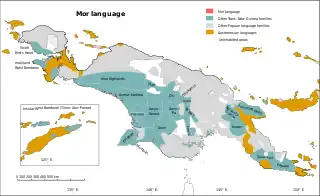| Mor | |
|---|---|
| Region | Fakfak Regency, West Papua |
Native speakers | 30 (2012)[1] 70 semi-speakers (2012) |
| Language codes | |
| ISO 639-3 | moq |
| Glottolog | morb1239 |
| ELP | Mor (Bomberai Peninsula, Indonesia) |
 Map: The Mor language of New Guinea
The Mor language
Other Trans–New Guinea languages
Other Papuan languages
Austronesian languages
Uninhabited | |
Mor is a nearly extinct Trans–New Guinea language of Indonesia. It is spoken along the Budidi River and the Bomberai River on the Bomberai Peninsula.[2]
Classification
It may form a tentative independent branch of that family in the classification of Malcolm Ross (2005), but Palmer (2018) classifies it as a language isolate.[3] However, the only connections are the 1sg and 2sg pronouns na- and a-:
| sg | pl | |
|---|---|---|
| 1 | na-ya | ne-a |
| 2 | a-ya | omase |
| 3 | mena | morimene |
Usher classifies it with the other Trans–New Guinea languages of the Berau Gulf.[4]
Nouns
Nominal inflection for number in Mor is limited to only certain animate nouns, such as mor ‘man’ and mor-ir ‘men’. Other nouns do not inflect for number, such as is ‘bird/birds’.[2]: 97
Vocabulary
The following basic vocabulary words are from Voorhoeve (1975),[5] as cited in the Trans-New Guinea database:[6]
gloss Mor head idura hair sa eye nana tooth nasona leg bana louse twoa dog afuna pig bia bird isa egg utreta blood wabmina bone weten skin gina tree wara man hiamia sun seba water sea fire taha stone puata name inagenena eat masmore one nadu two kin
A word list of Mor has also been collected by Johannes Anceaux.[7]
References
- ↑ Mor at Ethnologue (18th ed., 2015) (subscription required)
- 1 2 Pawley, Andrew; Hammarström, Harald (2018). "The Trans New Guinea family". In Palmer, Bill (ed.). The Languages and Linguistics of the New Guinea Area: A Comprehensive Guide. The World of Linguistics. Vol. 4. Berlin: De Gruyter Mouton. pp. 21–196. ISBN 978-3-11-028642-7.
- ↑ Palmer, Bill (2018). "Language families of the New Guinea Area". In Palmer, Bill (ed.). The Languages and Linguistics of the New Guinea Area: A Comprehensive Guide. The World of Linguistics. Vol. 4. Berlin: De Gruyter Mouton. pp. 1–20. ISBN 978-3-11-028642-7.
- ↑ New Guinea World, Mor
- ↑ Voorhoeve, C.L. Languages of Irian Jaya: Checklist. Preliminary classification, language maps, wordlists. B-31, iv + 133 pages. Pacific Linguistics, The Australian National University, 1975. doi:10.15144/PL-B31
- ↑ Greenhill, Simon (2016). "TransNewGuinea.org - database of the languages of New Guinea". Retrieved 2020-11-05.
- ↑ Smits, Leo and Clemens L. Voorhoeve. 1998. The J.C. Anceaux Collection of Wordlists of Irian Jaya Languages B: Non-Austronesian (Papuan) languages (Part II). Leiden-Jakarta: Department of Cultures and Languages of Southeast Asia and Oceania.
- Ross, Malcolm (2005). "Pronouns as a preliminary diagnostic for grouping Papuan languages". In Andrew Pawley; Robert Attenborough; Robin Hide; Jack Golson (eds.). Papuan pasts: cultural, linguistic and biological histories of Papuan-speaking peoples. Canberra: Pacific Linguistics. pp. 15–66. ISBN 0858835622. OCLC 67292782.
External links
- Timothy Usher, New Guinea World, Mor